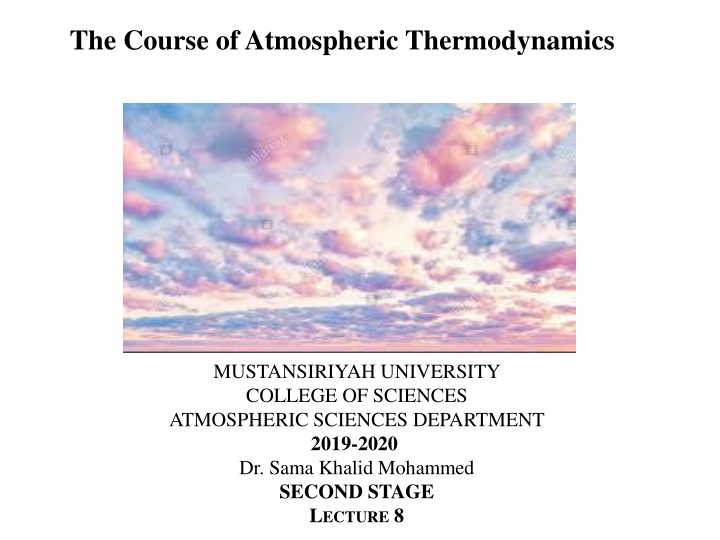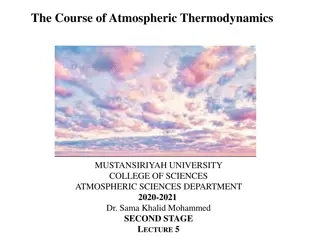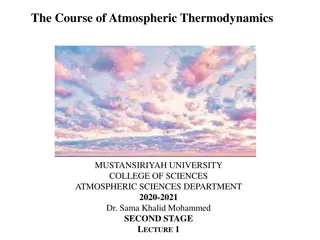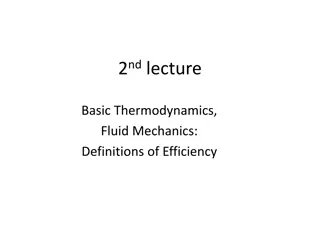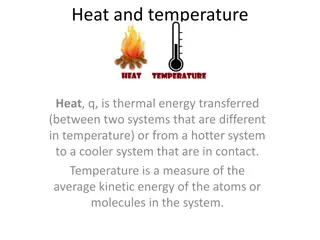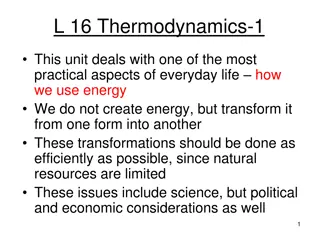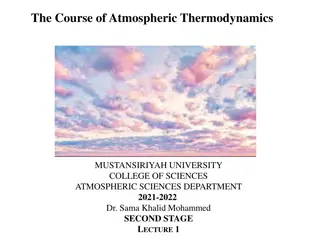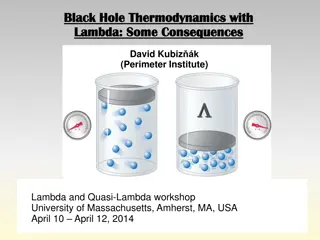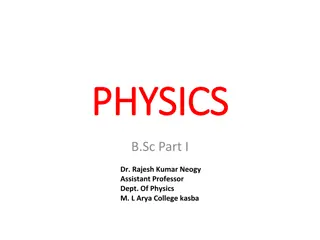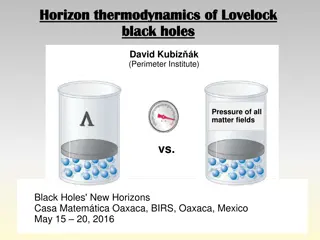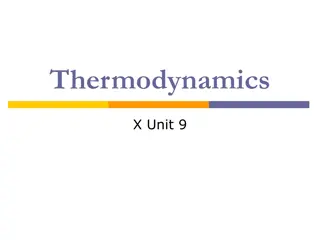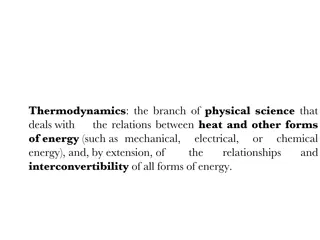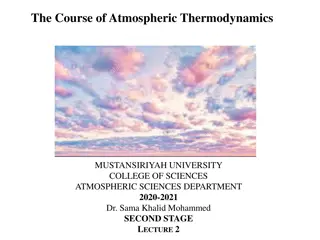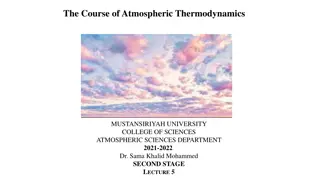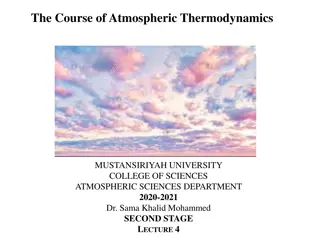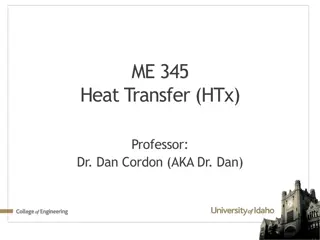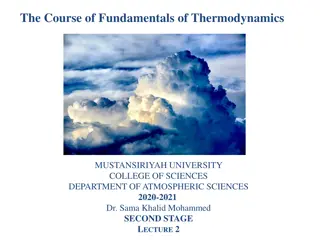The Course of Atmospheric Thermodynamics
The lines on a SKEW T-LOG P diagram play a crucial role in understanding atmospheric thermodynamics. These lines include isotherms, dry adiabats, and moist adiabats, each representing different properties of the atmosphere. By outlining and defining these lines, one can gain insights into temperature, pressure, and potential temperature variations in the atmosphere.
Download Presentation

Please find below an Image/Link to download the presentation.
The content on the website is provided AS IS for your information and personal use only. It may not be sold, licensed, or shared on other websites without obtaining consent from the author.If you encounter any issues during the download, it is possible that the publisher has removed the file from their server.
You are allowed to download the files provided on this website for personal or commercial use, subject to the condition that they are used lawfully. All files are the property of their respective owners.
The content on the website is provided AS IS for your information and personal use only. It may not be sold, licensed, or shared on other websites without obtaining consent from the author.
E N D
Presentation Transcript
The Course of Atmospheric Thermodynamics MUSTANSIRIYAH UNIVERSITY COLLEGE OF SCIENCES ATMOSPHERIC SCIENCES DEPARTMENT 2019-2020 Dr. Sama Khalid Mohammed SECOND STAGE LECTURE 8
Refresh Your Mind & Answer the Following? What are the lines of the SKEW T-LOG P diagram? Outline them and define each one.
Question #1 A parcel of air has a temperature of -51 C at the 250hPa level. 1. What is its potential temperature? 2. What temperature will the parcel have if it is compressed adiabatically to a pressure of 850 hPa? * Hint: It can be solved using the skew T - ln p chart.
Solution #1 1. Locate the original state of the air parcel on the chart at pressure 250 hPa and temperature -51 C. The label on the dry adiabat that passes through this point is 60 C, which is therefore the potential temperature of the air. 2. The temperature acquired by the ambient air if it is compressed adiabatically to a pressure of 850 hPa can be found from the chart by following the dry adiabat that passes through the point located by 250 hPa and -51 C down to a pressure of 850 hPa and reading off the temperature at that point. It is 34.0 C.
Follow the dry adiabat to 850 hPa Cabin pressure 850 hPa Temperature ~43 C
Question #2 An air parcel at 1000 hPa and 18 C has a mixing ratio of 6 g/kg. 1. What is its relative humidity and dew point temperture? * Hint: It can be solved using the skew T - ln p chart.
Solution #2 1. First locate the point with pressure 1000 hPa and temperature18 C. We see from the chart that the saturation mixing ratio for this state is 13 g/ kg. Since the air specified in the problem has a mixing ratio of only 6 g/ kg, it is unsaturated and its relative humidity: R.H. = w/ws x100% = 6/13 * 100%=46%. 2. To find the dew point we move from right to left along the 1000 hPa until we intercept the saturation mixing ratio line of magnitude 6 g/kg; this occurs at a temperature of about 6.5 C. Therefore, if the air is cooled at constant pressure, the water vapor it contains will just saturate the air with respect to water at a temperature of 6.5 C which is the dew point of the air.
w = 6 g/kg ws RH=6/13*100=46% Dewpoint ~6.5oC
Refresh Your Mind & Answer the Following? Define LCL(Lifting Condensation Level
Question #3 A parcel of air with an initial temperature of 15 C and dew point 2 C is lifted adiabatically from the 1000-hPa level. 1. Determine its LCL and temperature at that level. 2. If the air parcel is lifted a further 300 hPa above its LCL, What is its final temperature and how much liquid water is condensed during this rise? * Hint: It can be solved using the skew T - ln p chart.
Solution #3 1. locate the initial state of the air on the chart at the intersection of the 15 C isotherm with the 1000-hPa isobar. 2. The saturation mixing ratio line that passes through the 1000-hPa pressure level at 2 C is found to be about 4.4 g kg. 3. Because the saturation mixing ratio at 1000 hPa and 15 C is about 10.7 g/kg, the air is initially unsaturated. 4. Therefore, when it is lifted it will follow a dry adiabat (i.e., a line of constant potential temperature) until it intercepts the saturation mixing ratio line of magnitude 4.4 g/kg. Following upward along the dry adiabat that passes through 1000 hPa and 15 C isotherm, the saturation mixing ratio line of 4.4 g/kg is intercepted at about the 820- hPa level. This is the LCL of the air parcel. The temperature of the air at this point is about -0.7 C.
Solution #3 For lifting above this level the air parcel will follow a saturated adiabat. Following the saturated adiabat that passes through 820 hPa and 0.7 C up to the 620-hPa level, the final temperature of the air is found to be about -15 C. The saturation mixing ratio at 620 hPa and -15 C is 1.9 g/kg. Therefore, about 4.4-1.9=2.5 g of water must have condensed out of each kilogram of air during the rise from 820 to 620 hPa.
LCL A(1000,15,W) B(1000,2,Ws(A))
MCQ 1. A parcel of air rising when plotted on the Skew-T can only __________ as it rises. a. Warm b. Cool c. Remain isothermal
MCQ 2. National Weather Service weather balloon launches are done _________ time(s) per day. a. One b. Two c. Three d. Four
MCQ 3. The environmental temperature is the: a. Wet or dry adiabatic lapse rate b. Parcel lapse rate c. Dewpoint lapse rate d. Actual temperature measured by the weather balloon
MCQ 4. Lifted unsaturated air will _____________ in relative humidity. a. Increase b. Decrease c. Have a constant value
MCQ 5.At a particular pressure level, this is the temperature that results after complete evaporation occurs into initially unsaturated air: a. Dewpoint b. Mixing ratio c. Wet Bulb d. Potential
MCQ 6. This is the distance between two pressure levels and is a function of the temperature and moisture characteristics of that column of air between two pressure levels: a. Thickness b. Helicity c. SWEAT d. Temperature gradient
MCQ 7. An inversion is ______________. a. A wind shift with height b. A temperature increase with height c. A dewpoint increase with height d. A temperature decrease with height
MCQ 8. If the temperature is -5 C and the dewpoint is -10 C then the dewpoint depression in Celsius difference is: a. 15 b. -5 c. 5 d. 15
MCQ 9. A line of equal temperature is called a(n) __________________. a. Isodrosotherm b. Height contour c. Thickness line d. Isotherm
MCQ 10. The wet adiabates will be nearly parallel to the dry adiabates when rising saturated air is: a. Very warm b. Accelerating c. Very cold d. Deceleration
MCQ 11. The dry adiabatic lapse rate is equal to: a. 9.8 C/km b. 6.5 C/km c. 5.5 C/km d. 1.0 C/km
